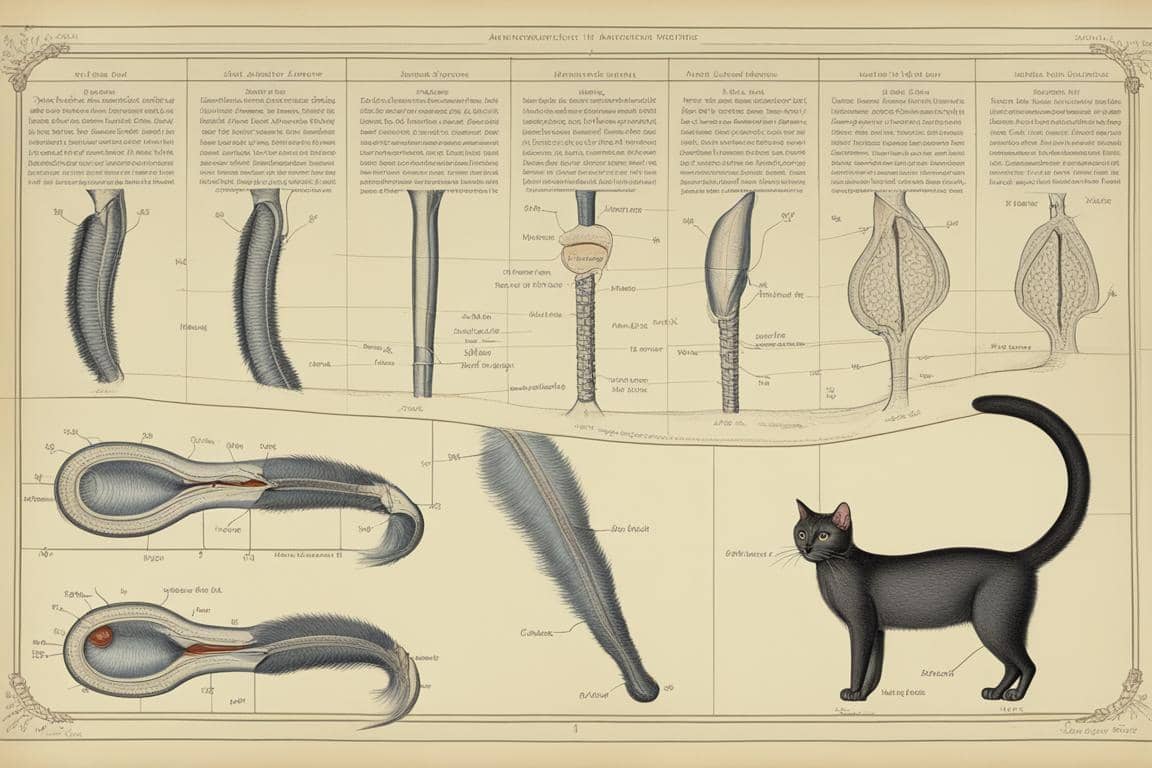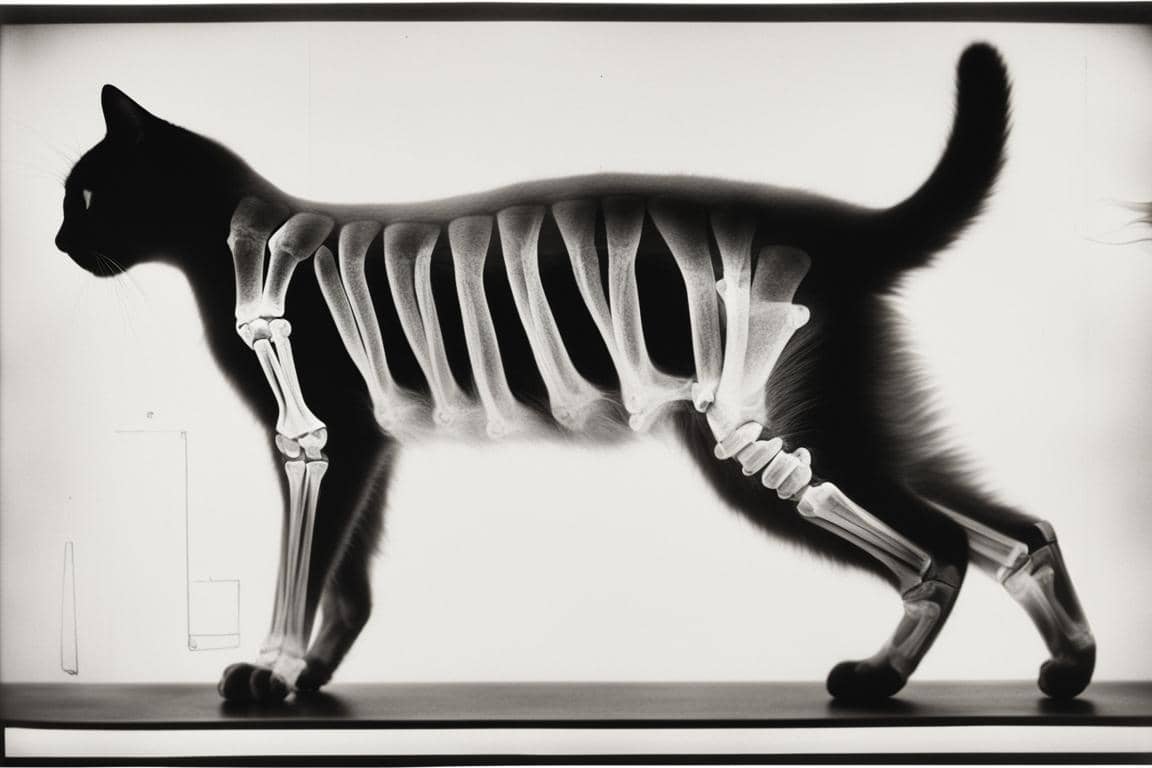What Is a Cat’s Tail Made Of?
The very notion that a cat’s tail could casually detach and tumble to the ground like a fallen leaf is, quite frankly, absurd. Yet, it’s a notion that seems to have found a nook in the public consciousness, perhaps born from tall tales and feline folklore. Let me be the one to dispel the myth: No, a cat’s tail cannot ‘fall off’ in the casual sense of the term. But let’s not get ahead of ourselves. The anatomy of a cat’s tail is a marvel, a complex assembly of bones, muscles, nerves, and skin, all working in concert to facilitate a range of functions that are as critical as they are fascinating.

Indeed, a cat’s tail is a continuation of its spine. To understand it, we must venture beyond the fluffy exterior to the skeletal architecture. Picture vertebrae, those small, interlocking bones that protect the spinal cord and provide structural support. A cat’s tail is composed of 18 to 23 of these vertebrae, each cocooned in muscle, connective tissue, and skin. It is an appendage that can express the subtlest of sentiments, balance the lithe body during acrobatic feats, and act as a rudder to steer through the high seas of their domestic jungles.
Can a Cat’s Tail Fall Off?
By reading this article, you will learn:
– Yes, a cat’s tail can fall off due to injury or medical conditions.
– The most common tail injuries in cats are fractures, nerve damage, and degloving injuries.
– Tailless Manx cats are the most common tailless breed due to a genetic mutation.
Why Do Cats Have Tails?
Balance
Lets talk about balance – a cat’s tail is an exquisite balancing apparatus. When I watch my cat, Luna, traverse the narrow ledge of our fence, her tail sways with a dancer’s grace, each movement a counterbalance to the sway of her body. It’s a high-wire act performed daily, with nary a net in sight.
Communication
And then there’s communication. Tail language is a lexicon all its own. The flicks, twitches, and swishes all denote different messages. I’ve come to interpret Luna’s tail wraps around my leg as a sign of affection, akin to a warm embrace.
Temperature Regulation
On chilly evenings, you might find your feline companion curled up, tail snugly wrapped around their body. It’s not just for comfort; it’s an innate survival mechanism for temperature regulation, conserving heat that might otherwise be lost.
Hunting
In the pursuit of prey, a cat’s tail can serve as a counterweight, aiding in those gravity-defying pounces that seem to violate the laws of physics.
Play
During play, a cats tail is an indicator of their excitement levels – the faster the wag, the greater the thrill.
Grooming
Grooming, too, is an occasion for the tail to play its part, often used to cover the face during the delicate task of washing.
Self-Defense
And let’s not overlook the role of self-defense. A puffed-up tail is a clear signal: back off.
Expression of Emotion
Finally, the expression of emotion through the tail is something to behold. A gentle sway might signal relaxation, while a low, twitching tail could be a precursor to annoyance or aggression.
What Is a Cats Tail Made Of?
Delving deeper into the tail‘s anatomy, we find a symphony of nerves running the length of the vertebrae, controlling movement and sensation. A break or injury here can be a serious affair, affecting everything from mobility to mood.
How Many Bones Are in a Cats Tail?
The number of bones in a cat’s tail varies, but typically ranges from 18 to 23, as mentioned previously. Each bone is a cog in the wheel of agility that defines feline movement.
Insider Tip: Counting the bones in your cat’s tail isn’t just a quirky pastime, it’s a window into understanding their flexibility and range of motion.
Can a Cats Tail Fall Off?
So, can a cat’s tail fall off? Not spontaneously, no. However, severe injuries, such as those resulting from accidents or fights, can lead to situations where medical intervention may necessitate amputation.

What Should I Do If My Cats Tail Falls Off?
If your cat sustains an injury that severely damages the tail, it’s imperative to seek veterinary care immediately. The tail is an extension of the spinal column, and injury to it can cause serious complications.
For those interested in how to care for an injured feline, this guide is an invaluable resource.
What Are the Most Common Cat Tail Injuries?
Common tail injuries include fractures, dislocations, nerve damage, and skin lacerations. Each of these can have varying degrees of severity and may present differently in behavior and symptoms.
How Can I Tell If My Cats Tail Is Injured?
A cat with a tail injury may exhibit signs such as reluctance to move, aggressive behavior when the tail is touched, abnormal tail positioning, or even loss of control over urination and defecation due to nerve damage.
How Are Cat Tail Injuries Treated?
Treatment for tail injuries ranges from conservative management, like rest and anti-inflammatory medications, to surgical interventions in more severe cases.
Insider Tip: Always observe your cat’s tail movements – they can be the first indicator of discomfort or injury.
Real-Life Tail Injury: Sarah’s Experience
Sarah, a long-time cat owner, noticed something was off when her normally playful cat, Whiskers, became unusually withdrawn. She also observed that Whiskers was not moving his tail as freely as before. Concerned, Sarah took Whiskers to the vet, where they discovered that he had sustained a tail injury, likely from a neighborhood scuffle.
Identifying the Injury
The vet explained to Sarah that tail injuries in cats can often go unnoticed, as cats tend to be very stoic in hiding their pain. Sarah learned that signs of a tail injury can include reduced tail movement, sensitivity around the tail area, and changes in behavior.
Treatment and Recovery
Whiskers received treatment and, with proper care, his tail healed over time. Sarah had to ensure that Whiskers didn’t engage in vigorous activity during his recovery to prevent further injury. Through this experience, Sarah gained valuable knowledge about the importance of monitoring her cat’s tail for any signs of injury.
This real-life example highlights the importance of being vigilant about cat tail injuries and seeking prompt veterinary care when necessary.
Can a Cat Live Without a Tail?
Yes, a cat can live without a tail, though they may need to adjust their balance and communication habits. It’s a testament to their adaptability and resilience.
What Is the Most Common Tailless Cat Breed?
The Manx cat is the poster child for taillessness. Originating from the Isle of Man, this breed naturally carries a gene that shortens the tail. Some are born completely tailless, while others have a small stub.

What Is the Most Commonly Asked Question About Cats Tails?
Apart from whether they can fall off, people often wonder about the meanings behind a cat’s tail movements. The curiosity underscores our desire to understand these enigmatic companions who share our homes and lives.
In conclusion, the feline tail is an appendage of wonder and utility – a barometer of mood, a tool of communication, and an instrument of balance. To worry about it falling off is to miss the marvel of its existence. It is a part of the cat’s identity, as expressive as their eyes and as unique as their purr. So next time you catch yourself fascinated by your cat’s tail, remember that it is far more than just an accessory; it is a vital part of their being, deeply woven into the tapestry of their feline finesse.
FAQ
Can a cat’s tail fall off?
Yes, a cat’s tail can fall off due to injury or medical conditions.
What should I do if my cat’s tail falls off?
Take your cat to the vet immediately for proper evaluation and treatment.
How can I prevent my cat’s tail from falling off?
Keep your cat away from potentially dangerous situations and provide a safe environment.
Who can help if my cat’s tail falls off?
A veterinarian is the best person to help with a cat’s tail injury or condition.
What if my cat’s tail falls off naturally?
Cats can lose their tails naturally due to genetics or breed traits, it’s not necessarily a cause for concern.
Can a cat live a normal life without a tail?
Yes, cats can adapt to life without a tail and continue to live happily and healthily.




Leave a Reply